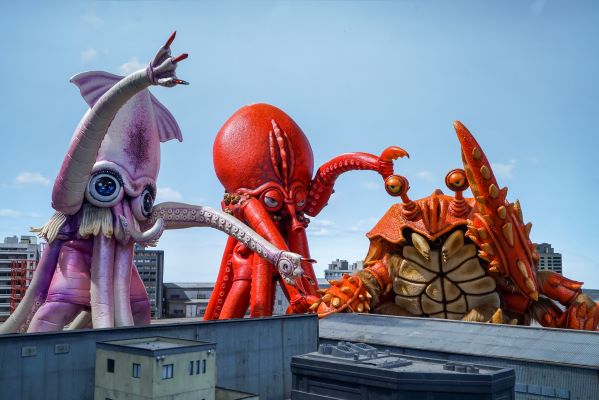Attempting to imitate the infamous Kaiju genre, known for giving the world Godzilla, Rodan and Mothra, Monster Seafood Wars leaps out of the gate with ridiculous strides, a ludicrous script, and lashings of exuberant Japanese enthusiasm. In part a mockumentary, Monster Seafood Wars frames itself with a news crew interviewing a survivor and lead member of SMAT (Seafood Monster Attack Team) as he recounts the events leading up to and dealing with the invasion of Inkala, Takolla and Kanilla, genetically modified squid, octopus and crab respectively.
What initially plays the part of a schlock B-movie wannabe seems to wildly stagger into distractions from its main attractions – as a narrative concerning two young geniuses, whose ideas include a revolutionary rice vinegar cannon to ‘tenderise’ the monsters quickly dilutes itself as it jumps to-and-fro from epic Kaiju battle to perplexing teen drama; even a 15-minute cookery montage.
The film’s structure unnecessarily divides itself between unusual subplots which the script fails to expand upon or take full advantage of. In a peculiar subplot which examines the political nature of Japan’s relationship with immigration and multi-culturalism encroaching on tradition, the film begins to take bold steps which are quickly cut off and never addressed again. All the while there is a severe imbalance with how blasé and flippant the film flops between comedic segments, sentai-style battles and an awkward, frankly concerning love triangle between the three leads Yûya Asato, Ayano Yoshida Christie and Hide Fukumoto.
This can be seen at its worst as the film comes to a complete halt as a two-minute joke suddenly refuses to dissipate; instead, serving up a prolonged sequence surrounding eating habits, monster food and the moral implications of eating the Kaiju meat. At first creative, turning the torn tentacles or limbs into delicious morsels which could end world hunger, the sequence overstays itself by another ten minutes.
Individually, the lead trio plays their respective parts well; Asato and Yoshida Christie as the magnificent young minds who disagree on how to deal with the threat, and a charming turn from Fukumoto as a head-strong and capable researcher. With the inclusion of a love triangle, it lowers the tone of the film. Yes, even in a film about giant seafood monsters. There is little chemistry in the romantic sense, and the whines and blackmail concerning the boy’s pursuits of Fukumoto’s character come across as grotesque, rather than cute or comedic.
Where the film finds its footing is when we dive back to the present-day recount of events where the serious, grave tone intensifies the comedic tone, embracing the ridiculous plot. Or when the focus shifts to the monsters duking it out, destroying the city and fighting off the armed forces, who come to the party armed with vinegar cannons and robotic chefs. The mockumentary aspect suits the less than stellar camera work, which relies on a lot of shaky-footage and ‘authentic’ camera techniques.
Strikingly imaginative, the monster costumes themselves are a key selling feature for the film and serve to demonstrate the creativity and history of Japanese cinema, particular the Kaiju genre. Creative enough to convey workshop designs, tacky enough to emanate the ‘vibe’ of the style aimed for, the four outfits, as well as the films general model work and costume has a clearer vision than any of the direction or writing. One thing can be said for the film, by lord you’ll crave sushi and a bottle of Umeshu as the credits roll. Food to satiate the hunger, drink to stave off the confusion. Monster Seafood Wars takes brilliantly inventive raw ingredients but finds itself too interested in pushing accoutrements to appreciate what this film, at its core, should have been.
